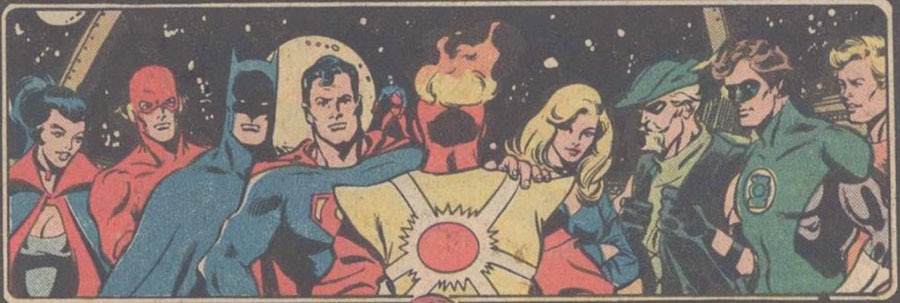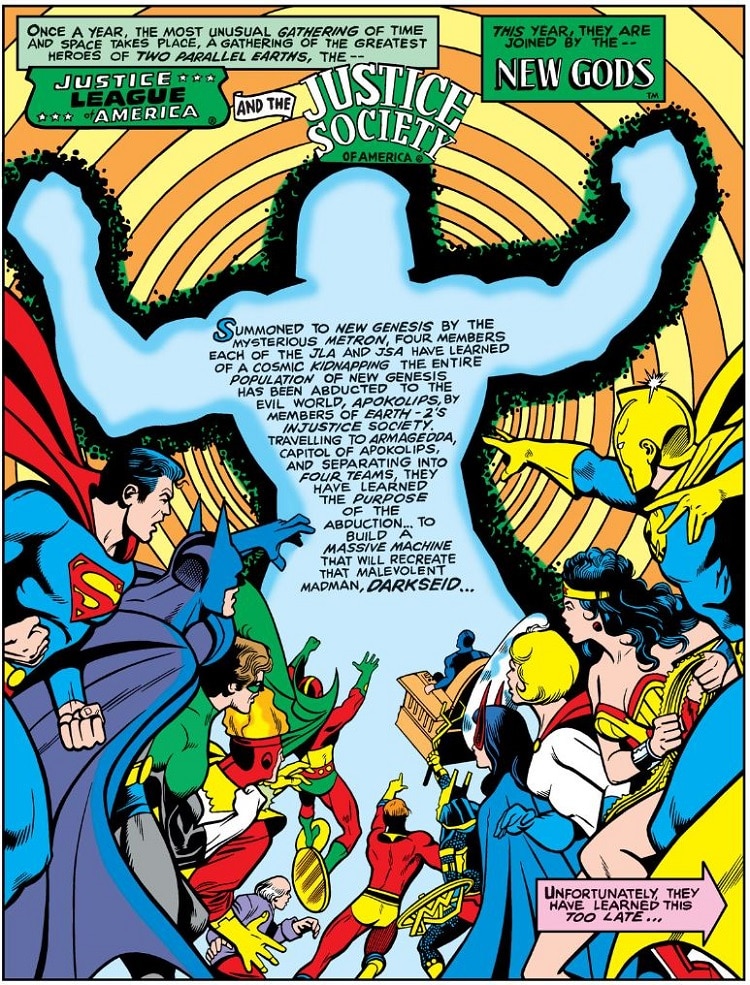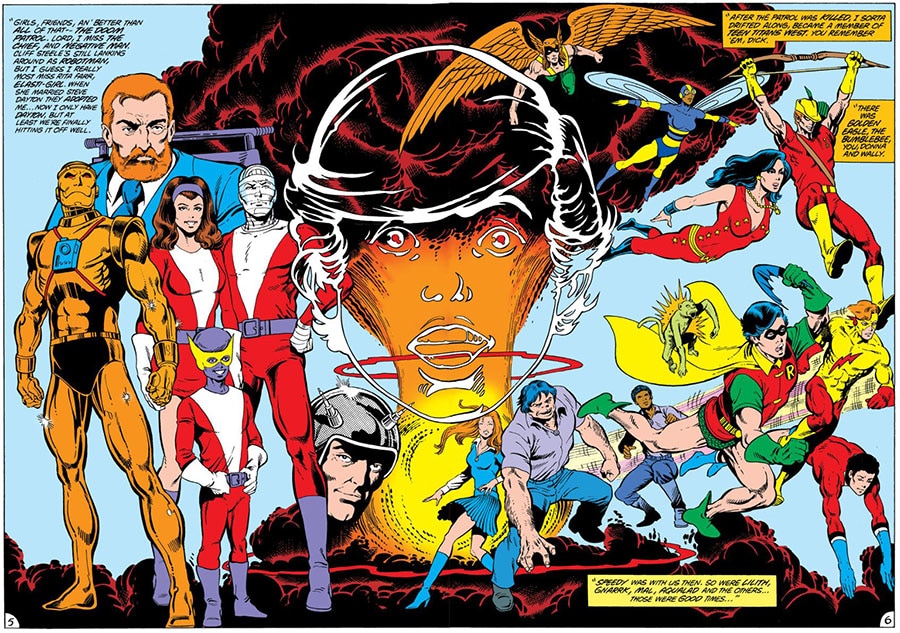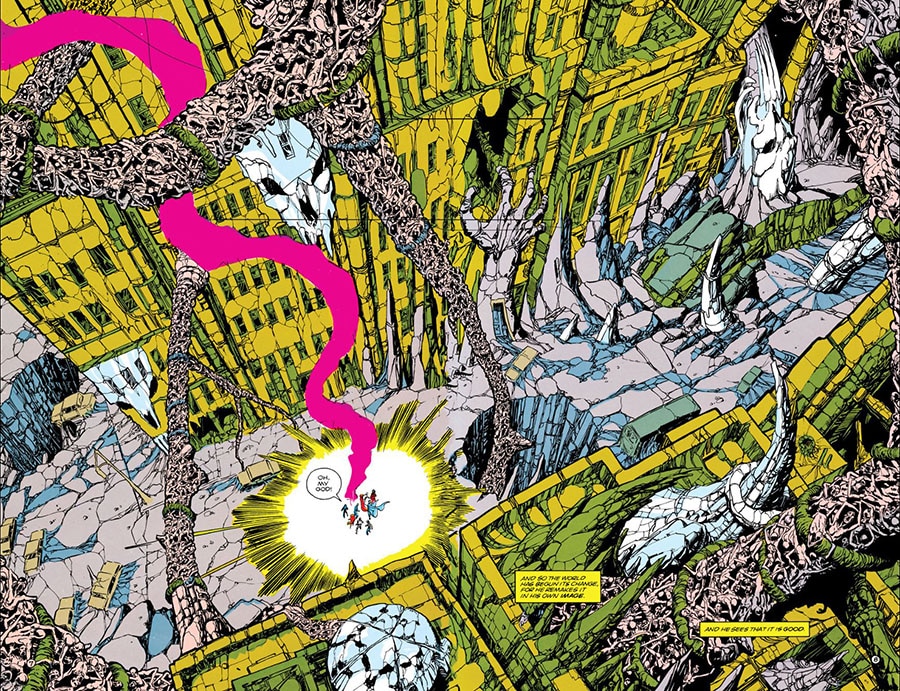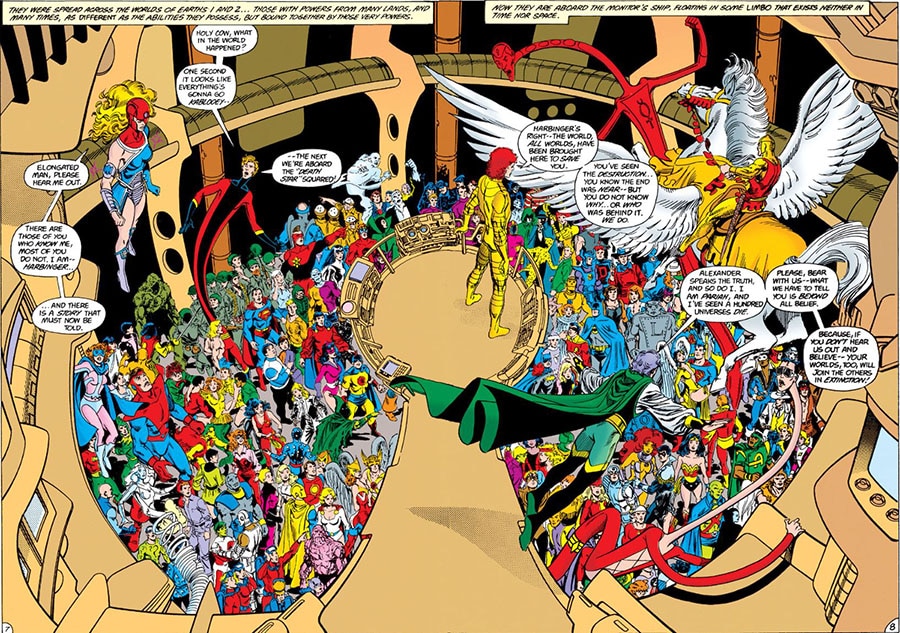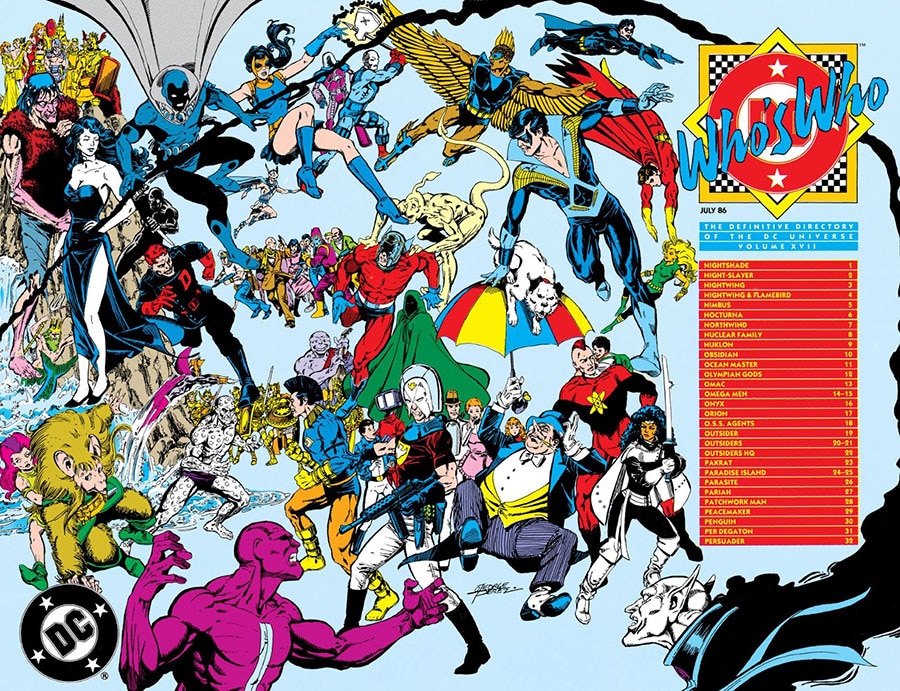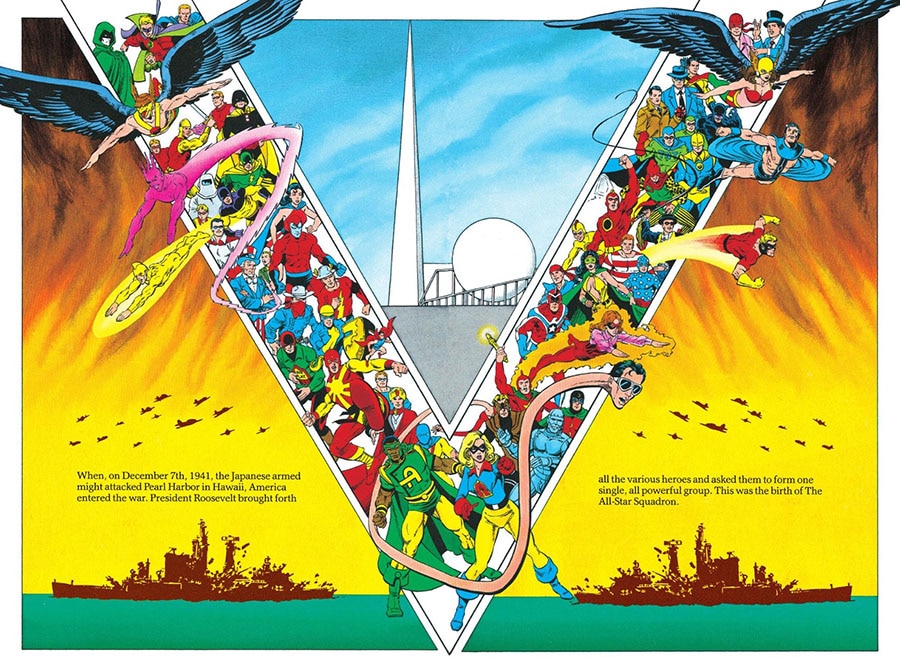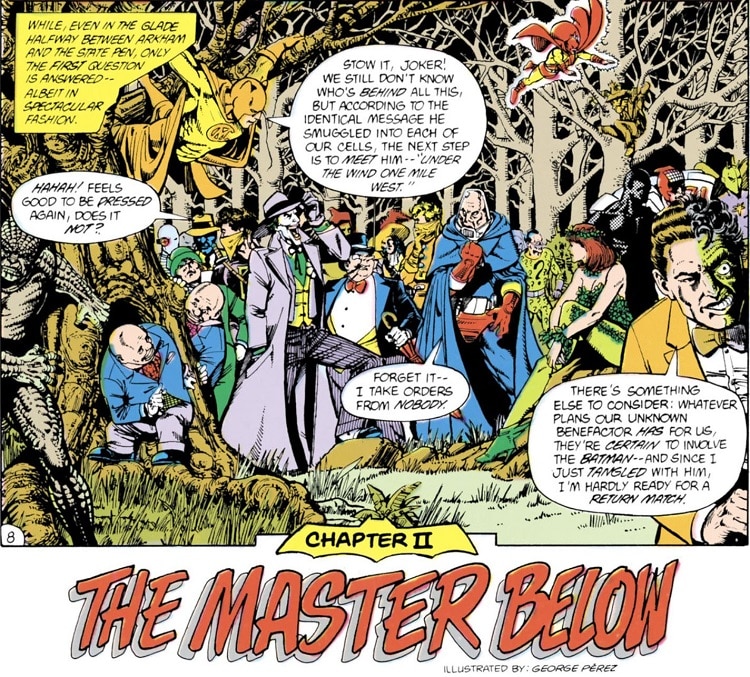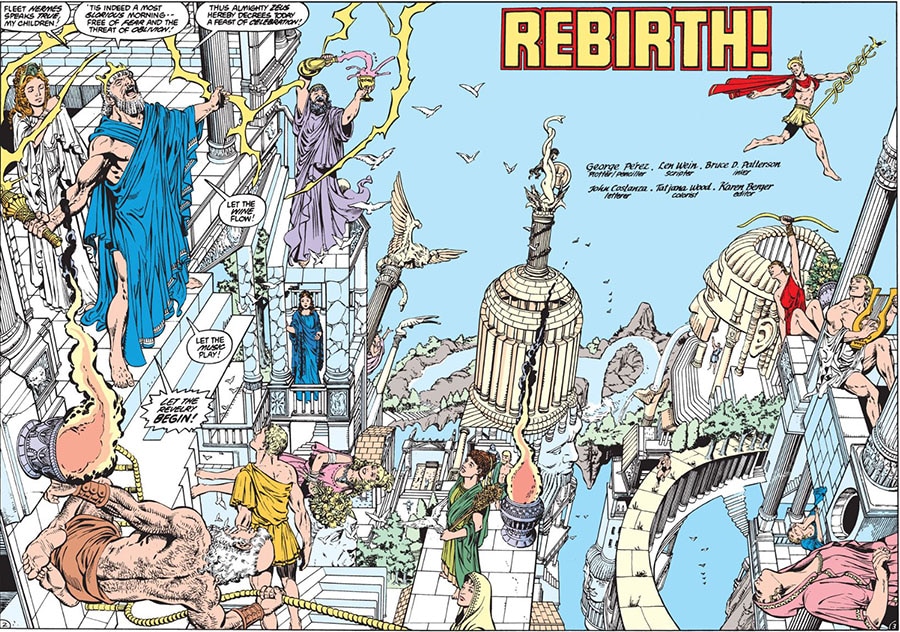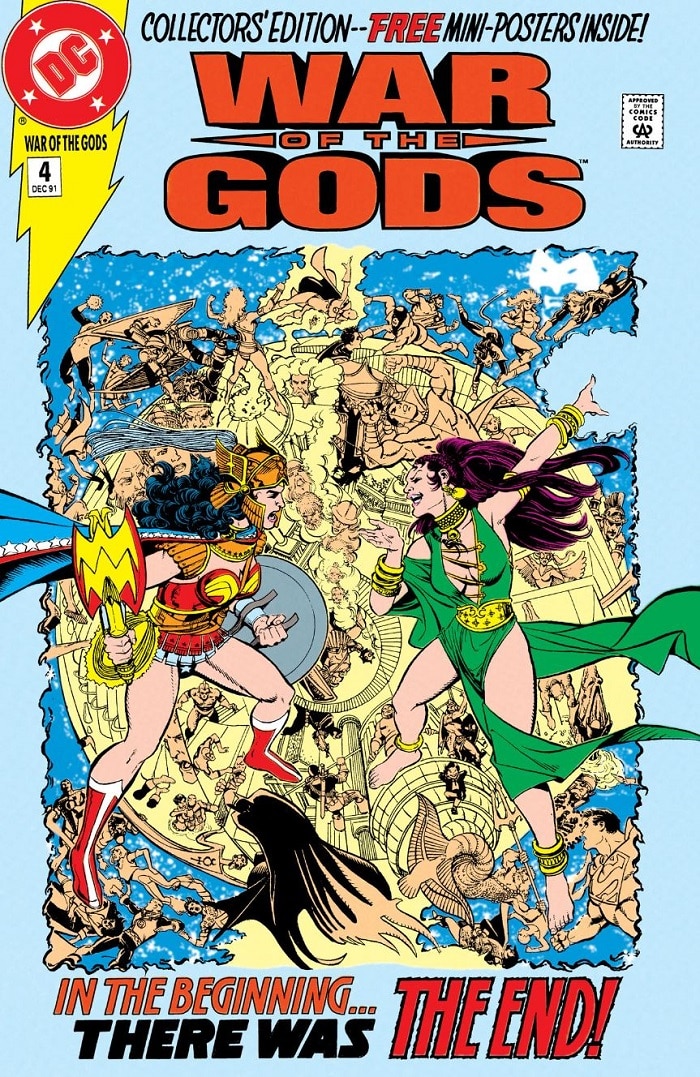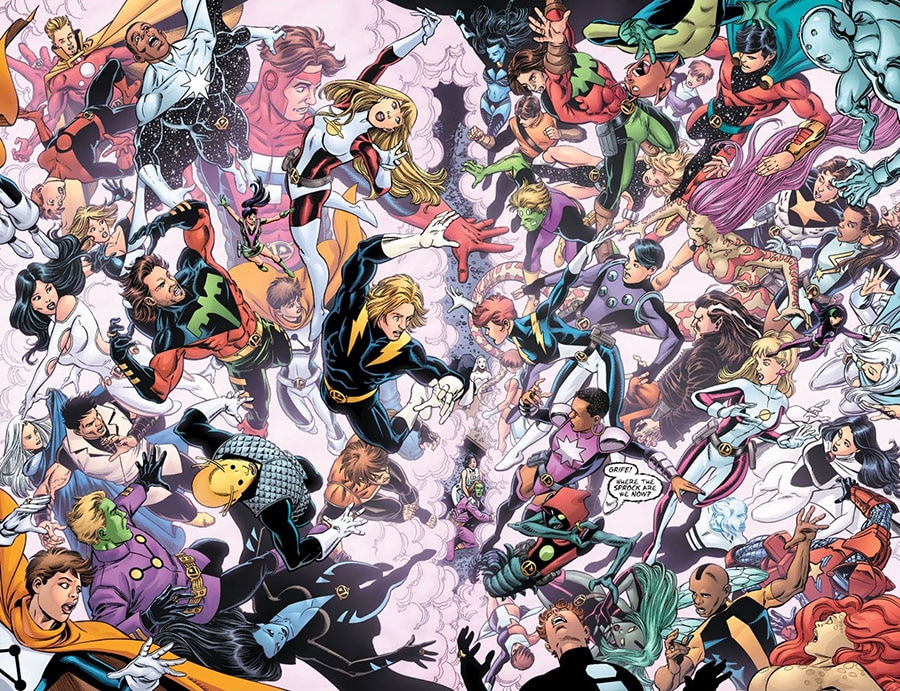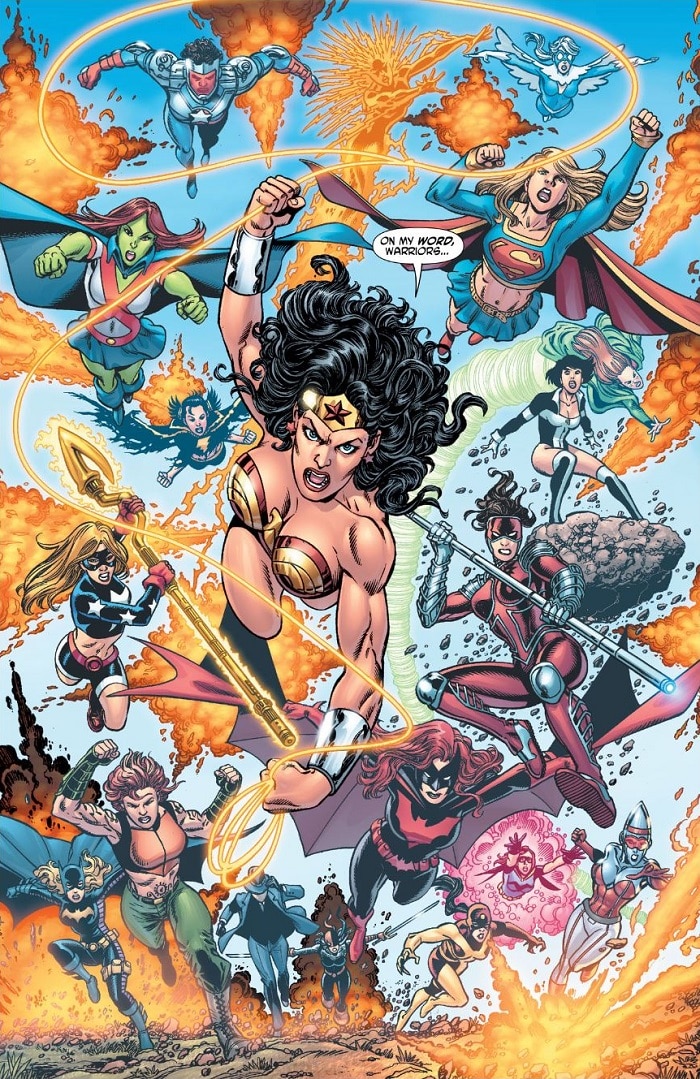George Pérez, the Wonder Woman, Teen Titans and Crisis artist who brought the DC Universe to life like no one else before or since, passed away last month at the age of 67. It’s impossible to overstate just how big an impact Pérez had not just on DC, but on the very art of comics itself. So, all this month, we’ll be doing our best to highlight just some of the accomplishments Pérez made as a creator at DC which have inspired so many. Pérez co-created the most definitive Teen Titans ever devised and breathed new life into the clay of Wonder Woman, but that’s not what we’re here to talk about today. Today, we recognize George Pérez as the undisputed king of one of the greatest feats in comic book artistry: the group shot.
The group shot is a feat where an artist dynamically captures an overwhelming number of characters within a single tableau, showcasing each character individually while presenting them as part of a greater whole. A great group shot suggests that all the characters you’re seeing have rich stories of their own, but also live within the same space as each other—an integral message when presenting a sprawling, fictional universe. It stands for the possibility within the entire world it represents. And if there was ever one king of the group shot, it was George. Pérez’s specialty was never just a single character, but a world of them. Today, it’s impossible to even attempt a group shot without drawing inspiration from, let alone comparison to, the work of George Pérez.
We’d say more, but it may be best to let the art do most of the talking. Here, we’d like to present you with some of our favorite Pérez group shots from his tenure at DC. We’ll always miss his grand perspective, but the hundreds of stories he drew will continue to drive us for generations.
The Flash #290 (1980)
This simple Justice League roster panel may not look like much, but it’s the first group assembly of heroes George Pérez ever drew for DC, in a Firestorm backup to The Flash. It’s appropriate that this panel depicts Firestorm’s acceptance and induction into the Justice League of America, as the DC Universe was itself opening to Pérez’s rapidly developing talents.
Justice League of America #184 (1980)
Not long after both Firestorm and Pérez himself were inducted into the Justice League, our artist was already taking on ambitious cosmic projects, with the Justice League of America, the Justice Society of America, and the New Gods of New Genesis all battling the forces of Darkseid in a three-part JLA story. Notice here how the three factions all converge from different sides of the page towards a focal point, the imposing silhouette of the DC Universe’s greatest enemy towering above them all. Right from the start, Pérez knew how to draw a diverse array of heroes without losing the meaning of what was at stake.
Tales of the New Teen Titans #3 (1982)
With his collaborative partner Marv Wolfman, George Pérez helped redefine the Teen Titans from a team of superhero sidekicks into the voice of a new generation. With new characters like Starfire, Raven and Cyborg presenting worlds of possibilities for storytelling, the sky was the limit. But along with much of the previous Teen Titans team, Wolfman and Pérez also made a surprising draft of Beast Boy, formerly the youngest member of the Doom Patrol, and an ancillary member of the original Titans. In their Tales of the New Teen Titans, the newest members of the team catch the readers up on their unique backstories. In this evocative illustration from Beast Boy’s tale, we see his world explode behind him as the Doom Patrol is claimed by tragedy, followed by new beginnings with a team of heroes he can call his peers.
The New Teen Titans #3 (1984)
The demon Trigon is perhaps the most frightening of all George Pérez’s creations, with an immense power to distort whichever world he claims into a horrible reality indistinguishable from hell itself. In the first arc of Wolfman and Pérez ’s relaunched New Titans series, the Titans witness the terror of Trigon firsthand and the results feel like they came out of a Hieronymus Bosch painting. Filled with details of uncountable writhing bodies which form the architecture of the blasted landscape itself, this double page spread alone is filled with so much gruesome detail that you can’t help but gaze deeply into the abyss.
Crisis on Infinite Earths #5 (1985)
It’s so hard to pick a single page from Crisis on Infinite Earths to represent George Pérez’s work. The entire twelve-issue event is considered by many to be his magnum opus—an undertaking to include the entirety of the DC Universe and all it entails within a single world-shattering finale to fifty years of stories. But if we had to pick a single instance to encapsulate its grandeur, it would be this conference of the combined army of DC heroes with their unlikely savior, Alexander Luthor Jr. of Earth-3. Its overhead perspective provides a depth of field which allows you to feel the presence of every character in the scene, each of which, from Elongated Man to Plastic Man, are moved to express themselves in a visual way. This two-page spread may well be the platonic ideal of crowd shots, providing enough visual interest to keep you staring long after you’ve left the shop.
Who’s Who: The Definitive Directory of the DC Universe (1985-1986)
Some of George Pérez’s greatest DC work wasn’t for a traditional comic at all, but for a visual encyclopedia. In 1985, DC began publication of an alphabetical “Who’s Who” of DC’s most essential characters, soliciting character art from the greatest working comic artists of the ‘80s. Pérez’s work was present in every issue, but where he really shone was in his elaborate tableaux of the characters profiled in each installment. Pérez contributed the first five of these covers, and later issues #13-#18, and set a tough pace to follow for the many other artists involved. But then, it was always Pérez ’s role to inspire others to get to his level, and it always will be.
The History of the DC Universe (1986)
As if Crisis on Infinite Earths weren’t ambitious enough, Wolfman and Pérez followed up the event with a two-volume history of the DC Universe, laying out the entire streamlined timeline for a Post-Crisis world. Pérez’s work sings throughout this collection, lending his unique flair to every conceivable setting of the DC Universe, and in presenting its characters together, he was no less bold.
Batman #400 (1986)
We’re including this one just because it’s one of the few times George ever drew a purely Batman story, and it’s a hell of a panel. In just a piece of a page, Pérez presents us with a personality-filled gathering of all of Batman’s greatest foes, simply existing together. There’s a casual atmosphere among this rogues gallery rarely seen when they’re assembled, lending a weight to their characters as not just obstacles for Batman to overcome, but people in their own right.
Wonder Woman #7 (1987)
As both writer and artist, George Pérez’s work on Wonder Woman was the most important and definitive the character had seen since the Golden Age of William Marston. The art frequently sang with triumphant feminine liberation, but was especially transformative when it came to scenes on Mt. Olympus—with the use of Escher-like techniques to present the gods who inhabit it as truly otherworldly. Where Pérez could be hellish with the realm of Trigon, here, his Greek pantheon was divine.
War of the Gods #4 (1991)
The final issue of Pérez’s War of the Gods event is a particularly poignant one in his career, and not just because it combined his gift for deific imagery in Wonder Woman with his maximalist approach to Crisis on Infinite Earths. This finale was also the first time Pérez would work with Phil Jimenez, who would eventually become a definitive Wonder Woman artist in his own right. Up through Wonder Woman Historia: The Amazons today, Pérez’s influences are apparent in all of Jimenez’s work, and that passing of the torch begins right here. We miss George every day, but it helps us to know that the collaborative spirit of the comic medium will ensure a part of him is always with us through the continuing art he inspires.
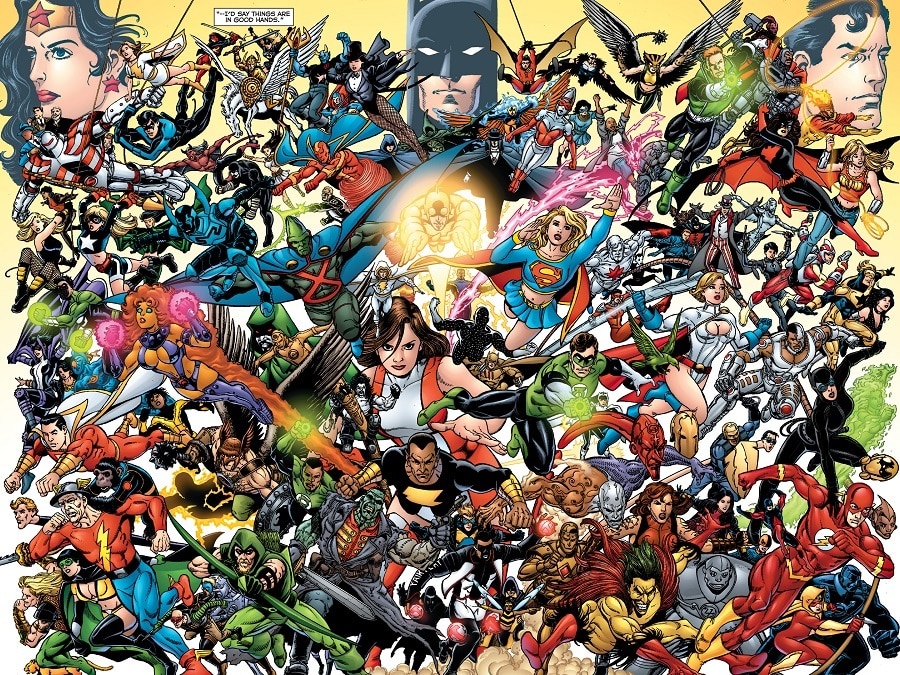
Infinite Crisis (2006)
Alongside Phil Jimenez, Ivan Reis and Joe Bennett, George Pérez was one of many to contribute to the thematic follow-up to his own Crisis. And while some truly inspiring Pérezian group shots are present throughout the book, this spread from the trade collection is our favorite. Because what it represents in the heroes it includes isn’t a tribute to DC’s past, but its upcoming future. Here, Infinite Crisis makes the statement that while DC will always celebrate its icons, new characters with new stories will always be integral to driving the DC Universe forward.
Final Crisis: Legion of Three Worlds #2 (2008)
George Pérez’s final fully drawn series for DC was nearly as ambitious as Crisis on Infinite Earth itself: a temporally fluctuous bacchanal of every incarnation of the Legion of Super-Heroes, across disjointed continuities. It’s bursting with dizzying shots just like this one and may well represent the best art of Pérez’s long and legendary career. But this particular spread, which dynamically features the two time-disjointed rosters of Legionnaires that have been pulled to a single point in space and time, best captures the ebullient force of this unique crossover between Legion, Legion and Legion.
Wonder Woman #600 (2010)
One of our favorite George Pérez pieces from his last years of drawing regularly for DC was this crowd shot in the landmark Wonder Woman #600. Where Wonder Woman once was the sole female representative of DC’s A-List, here Pérez reveals just how far Wonder Woman’s mission has come and everyone she’s inspired—a diverse array of heroines of every variety, who only continue to expand today. Pérez’s own run on Wonder Woman strived to convey a message of female empowerment. The heroes present behind Wonder Woman on this page show that Pérez truly did accomplish something great with the hero he’s most remembered for. With the outpouring of love for George Pérez we’ve seen throughout the world, it’s clear that just as Wonder Woman inspires all who follow her, the entire comics community will always follow behind the spirit of George Pérez, leading the charge forward.
One vast and perfect group shot.
Alex Jaffe is the author of our monthly "Ask the Question" column and writes about TV, movies, comics and superhero history for DCComics.com. Follow him on Twitter at @AlexJaffe and find him in the DC Community as HubCityQuestion.

